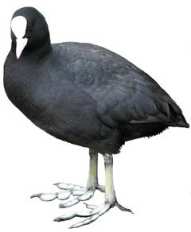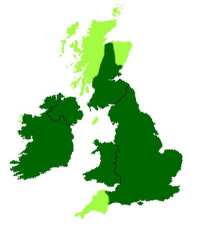|
|
Coot Plate | ||||
|
|
|||||
| Distinguishing Features |  |
||||
| Height 38cm (15in), Black plumage, with white bill and cap/sheild, also white wing bar seen in-flight. Both sexes are alike. | |||||
| Food | |||||
| Small aquatic animals, fish, newts, dragonfly nymphs and water plant roots and shoots. | |||||
| (Rallidae)
fulica atra |
|||||
|
|
|||||
 |
Nesting | ||||
| Between March and July. Clutch of 5 to 8 eggs, overall buff, with brown speckles. Incubation appx 22 days. Two broods tended by both parents. | |||||
| Habitat | |||||
|
Open stretches of water, lakes, gravel pits, estuaries. Common around urban parks and reservoirs. |
|||||
|
The darker green on the map above indicates
where you are most likely to see a Coot.
|
|||||
|
|
|||||
| Other information | |||||
|
Very common to these shores, the Coot will usually select a nesting area in large open stretches of water. The nest is built in the shallows and can float freely. Sometimes the nest may be attached to a overhanging branch. The Coot will build a raft or platform after the eggs have hatched to roost the chicks. Both parents will feed and tend the young. After about 8 weeks the young will be independent. Aggressive by nature the Coot will adopt a head down posture to protect its territory. They will also flock together in the water, kicking up large amounts of spray to ward off potential threats from birds of prey. |
|||||
| [Home] [News] [Gallery] [Birds] [Discover] [About] [Contact] [Members] | |||||